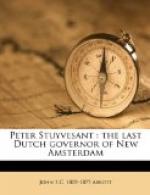“We regard that treaty as an absolute nullity—of no force. We shall govern ourselves entirely by the patent granted us by his majesty the king of England. The Dutch may hold as much as they now actually occupy. But that shall not hinder us from taking possession of any territory not occupied by them.”
The Dutch then proposed, by way of compromise, that for the present, Westchester should remain in possession of Connecticut, while the towns on western Long Island should remain under the government of New Netherland. To this the Hartford commissioners replied:
“We do not know of any province of New Netherland. There is a Dutch governor over a Dutch plantation, on the island of Manhattan. Long Island is included in our patent, and we shall possess and maintain it."[11]
Thus repulsed at every point, the Dutch agents commenced their return. They bore a letter to Stuyvesant from the General Assembly, in which, withholding from him the title of governor of New Netherland, they discourteously addressed him simply as “Director General at Manhattan.”
As we have mentioned, there were many English settlers in the Dutch towns on the western end of Long Island. In some of them it is not improbable that the English element predominated. In the letter sent by the General Court to Governor Stuyvesant, it was stated that Westchester and Stamford belonged to Connecticut; that, for the present, the General Court would forbear from exercising any authority over the English plantations on Long Island; but that, should the Dutch molest the English there, the Connecticut authorities would use all just and lawful means for their protection.
The situation of the Dutch province was now alarming in the extreme, and Governor Stuyvesant was environed by difficulties which no mortal sagacity or energy could surmount. His treasury was exhausted. The English settlers in the Long Island villages, were in determined and open revolt. And his English neighbors, whom he was altogether too feeble to resist, were crowding upon him in the most merciless encroachments.
Under these circumstances, he called a Convention, to consist of two delegates from all the neighboring villages, to meet at New Amsterdam on the 22d of October, 1663. Eight towns were represented.
The Convention adopted an earnest remonstrance to the authorities in Holland, in which the disastrous situation of the province was mainly attributed to their withholding that aid which was essential to the maintenance of the colony.
“The people of Connecticut,” the remonstrance stated,




